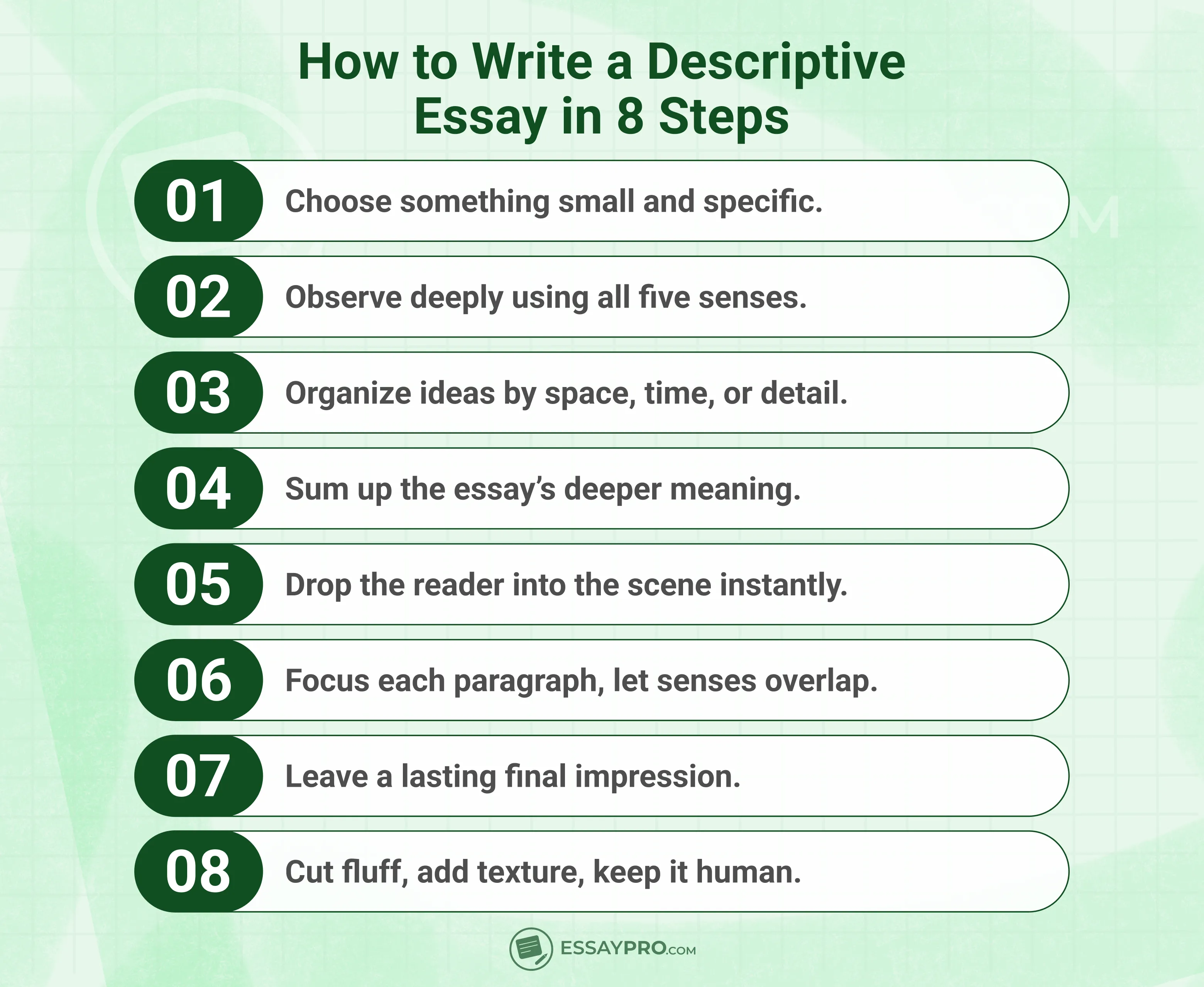A descriptive essay captures an object, person, place, or moment so vividly that the reader feels present inside it. It's writing that makes someone else see what you see or smell what you smell. It takes a moment and stretches it so the reader can step inside.
Here’s what it takes to craft descriptive essays:
- Collect the small details, like colors, sounds, and textures, you notice when you pay attention.
- Outline so your thoughts don’t scatter everywhere.
- Write a thesis in a way that holds the whole thing together.
- Start with an introduction and open a door.
- Fill the body paragraphs with the things only you would notice.
- End with a conclusion that lingers a little, like the last note of a song.
- Then, cut what’s flat, and add what’s missing.
In the following sections, we’ll take a closer look at each of these steps. If at any point the words feel stuck in your head, EssayPro is here to help students untangle drafts and turn them into writing that feels alive.


What is a Descriptive Essay?
A descriptive essay is a form of creative writing that emphasizes sensory detail of a place, person, object, or moment and imaginative imagery and impressions. These essays will be non-confusing. They are direct and fact-based rather than opinion-based.
For instance, instead of merely stating that a park is beautiful, you would describe the tall grass, the weathered bench, and the distant sounds of traffic behind the trees.
It uses figurative language and literary devices, such as similes, metaphors, allegories, etc., to provide enough detail for the reader to have a clear picture of a place, a person, an object, or a moment.
What Is the Purpose of a Descriptive Essay?
The purpose of a descriptive essay is to force your brain to slow down, almost painfully so. You can’t just glance and write. You have to stare at things until they stop being ‘things’ and start becoming pieces of information you didn’t know were there. Descriptive essays don’t skip this part. They make you notice how the smell of bread in a hallway feels different from that in your kitchen.
The hidden purpose is training yourself to see, not to scroll or skim. And then pass that vision to someone else with words sharp enough to cut through the blur.
If that level of focus drains you, there’s nothing wrong with handing over the hard parts. EssayPro can take on the load, whether an essay or something much heavier, like help with dissertation.
How to Write a Descriptive Essay in 8 Steps
The writing process looks simple from the outside: describe something and you’re done, but the minute you sit down, you realize you’re supposed to notice the details your brain usually ignores. You end up staring at a wall, not because you’re stuck, but because the wall suddenly has more to say than you expected.
These tips for writing a descriptive essay will take you somewhere strange, only if you let it. Now, let’s get creative.

Step 1: Select Your Topic
Is there something that just won’t leave you alone? The thing that keeps popping into your head while you’re trying to think about literally anything else. Hold on to that. Professors dread reading essays about big things, like beaches, cities, sunsets, and they’re dead on arrival. Stand out by choosing something small, something you can zoom in on until it reveals itself.
A descriptive essay gets stronger (and harder to write) when the topic is deceptively simple. You can write about a matchbox and make it more interesting than someone writing about the Eiffel Tower. The topic just needs to hold still long enough for you to get under its skin.
If you’re hunting for inspiration and want to explore different angles for your writing, take a look at these narrative essay topics.
Step 2: Gather Details
You think you’re observing, but really you’re interrogating the world. So:
- Touch the thing
- Smell it
- Listen to it
- Let it annoy you
Does it sound ridiculous? Perfect - write it down. How a chair creaks like an old knee can be fascinating, and the way sunlight in one corner of the room feels colder than the rest can turn the reader’s senses upside down.
The best details for a descriptive essay usually come after the obvious ones run out. At first, you’ll write what everyone else sees: the color, the shape, the size. Then, when you think you’re done, stay there and wait.
Remember Flaubert? He could spend a whole page on the texture of a tablecloth, and Balzac would go even further, describing the table, the dust on it, the history of the dust, and what the dust says about the people who live there.
Step 3: Draft an Outline
When structuring your essay, you can organize your paragraphs from top to bottom or near to far, chronologically, or from general to specific. Here's a simple descriptive essay outline from our writers to guide you:
Step 4: Develop a Thesis Statement
The thesis runs throughout the entire essay as a pulse. Most people overcomplicate it with grand statements. Keep it simple: one clear line that says what this description is really about. Maybe you’re showing how an abandoned playground isn’t just empty, but eerie because you still hear the echoes. Maybe your focus is how a messy desk says more about a person than any photo ever could.
Think of it like the reason you’re telling the story at all. Without it, the details just float around without sticking to anything. The thesis ties them together without shouting for attention.
Step 5: Craft the Introduction
Start your descriptive essay introduction by throwing the reader into the middle of something right away. ‘This essay will describe’ will ruin everything. Imagine your readers walking into a mid-scene, and they have to catch up, not listen to you explaining what they’re seeing, hearing, smelling, tasting, or feeling.
You could open the sharp squeal of sneakers on an empty basketball court where every sound bounces back at you like it’s alive. Or maybe it’s just one bulb, buzzing and twitching in a hallway that smells like bleach and something older, something sour hiding under it.
Step 6: Compose the Body Paragraphs
Each paragraph should focus on one angle at a time, but don’t treat them like separate boxes to tick. Let the senses spill into each other. A smell can trigger a memory, and a color can feel like a sound. Readers remember writing that feels layered, not sorted into neat little sections.
Break up the rhythm. Some sentences can ramble, almost spilling over, while others are quick and sharp. Throw in an observation that surprises even you while you’re writing. Maybe the sound of rain reminds you of static on an old TV. Perhaps the taste of metal on your tongue after biting your lip makes the scene tense. Use those things because they’re the parts readers latch onto.
Also, let yourself drift. If describing a smell suddenly pulls you toward a memory, follow it. Real writing moves like thought, looping, circling back, stumbling, and jumping ahead. You can always edit later.
And here’s the secret: describing everything kills the essay. You don’t need every detail. You need the right ones that tell the reader something bigger than the sum of their parts.
Step 7: Conclude the Essay
In the conclusion, you step back and let the reader see the whole picture you’ve been building. No summaries, no ‘so in conclusion.’ Just let the final image land. Maybe it’s the way the room feels empty after everyone leaves, or the echo of a sound that’s already gone. Perhaps it’s something you only realized while writing it.
If the ending doesn’t feel inevitable like it was waiting for you the whole time, then something’s not right. Your conclusion must leave the reader with an almost physical sensation that they’ll hold long after the last sentence.
Step 8: Refine Your Essay
Most of us dread revision, but it’s when the writing stops being a pile of words and starts becoming something alive. Read it out loud and listen for spots where your voice stumbles or where it sounds too clean or way too safe. Fix what feels dead. Keep the rough edges that make it human.
- Cut the sentences that do nothing.
- Add the tiny details you forgot.
- Shift things around until the flow feels natural, not perfect.
Perfection is boring. Real writing has scratches, dents, and fingerprints all over it. That’s what makes it worth reading.
And step back when you’re done, when you’ve stared at it so long the words blur. If it feels like someone else could walk into that scene and see it, then you’ve done it.
Descriptive Essay Format
The format for a descriptive essay is usually a five-paragraph structure, but it’s just a suggestion. Most people still choose the classic version: an introduction, three body paragraphs, and a conclusion.
- The introduction is where you set the scene, but not in a boring ‘let me explain everything’ way. Show the reader where they are and who’s there with them, and don’t dump the whole story all at once.
- The first body paragraph dives into visuals. You’re building the image piece by piece, so the reader can almost see it forming.
- The second body paragraph deepens that view. Here’s where adjectives and comparisons work hard, slipping in metaphor or a strange simile that sticks.
- The third body paragraph expands the senses, such as sound, smell, and touch, because the world is layered.
- The conclusion will put it together without preaching. Leave the final paragraph with the one last image and do it so that it stays hours later.
Descriptive Essay Examples
These examples below reveal places, objects, and people with detail sharp enough to stay in your mind. Take a look.
Extra Tips for Writing a Descriptive Essay
There’s more to writing a descriptive essay than simply depicting what’s in front of you. You have to make the reader live your experience exactly the same way as you do. These extra tips will help you do that:
- Use all five senses: Describe what something looks, sounds, smells, feels, and tastes like. These layers will pull the reader in.
- Choose specific words: Use strong words and rely on hard-working and vivid verbs and nouns. For example, instead of writing ‘a very old house,’ describe it as ‘a house with paint curling off in thin strips.’
- Don’t clutter with descriptions: It’s important that you keep the perfect balance. Too many adjectives don’t help; rather, they weaken the image. Details paint the picture, not sentences overloaded with adjectives.
- Organize your observations: Yes, even creative writing needs a path. Move through the description logically, room to room, near to far away, or whatever order fits the scene.
- Focus on what only you notice: Include details that someone else might overlook and only you notice. The combination of those small things is what makes the essay unique.
- Read it aloud, then revise: You will notice where your descriptive essay falls short and where sentences sound flat. Remove words that contribute nothing to the image you’re trying to describe.
Final Thoughts
A descriptive essay teaches you to stop sleepwalking through the world and actually start sensing things. That’s the real win: learning to see. When you capture that on the page, the reader sees it too.
And when you’re drowning in drafts or can’t get past the first sentence, EssayPro’s descriptive essay writing service is like that friend who sits down, looks at your mess of notes, and says, ‘Okay, here’s what works.’
FAQs
How to Write a Descriptive Essay?
Start with something that doesn’t leave your mind, no matter what. Watch it, listen to it, and write a descriptive essay about the weird bits. Then arrange those pieces until it feels like someone could walk right into it.
What Is a Descriptive Essay?
A descriptive essay is a piece of writing that catches the reader's eye for a while. You describe a thing so precisely that they almost believe they’ve been there.
What Is the Purpose of a Descriptive Essay?
The purpose of a descriptive essay is to show the world as you see it and let someone else feel that moment as if it were theirs.

Daniel Parker
is a seasoned educational writer focusing on scholarship guidance, research papers, and various forms of academic essays including reflective and narrative essays. His expertise also extends to detailed case studies. A scholar with a background in English Literature and Education, Daniel’s work on EssayPro blog aims to support students in achieving academic excellence and securing scholarships. His hobbies include reading classic literature and participating in academic forums.
- Austin Peay State University Writing Center. (2024). Descriptive essay. Retrieved from https://www.apsu.edu/writingcenter/writing-resources/Descriptive-Essay-2024.pdf
- Carroll University Learning Commons. (n.d.). Descriptive essays. Retrieved from https://www.carrollu.edu/student-services/learning-commons/writing-resources/descriptive-essays







